|
|
|
Sort Order |
|
|
|
Items / Page
|
|
|
|
|
|
|
| Srl | Item |
| 1 |
ID:
084992
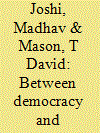

|
|
|
|
|
| Publication |
2008.
|
| Summary/Abstract |
The Maoist insurgency in Nepal presents an anomaly for students of civil war and democratic transitions. How was the Maoist wing of the Nepal Communist Party able to mobilize peasants to support their insurgency when they could not mobilize enough peasants to vote for them in elections? The authors address these questions by exploring the ways in which the persistence of traditional clientelist networks in the countryside enabled rural elites to mobilize peasants to vote for parties other than the Maoist party, even though peasants would have benefited from that party's advocacy for land reform. When that same party used insurgent violence against rural elites, peasants were willing and able to support the insurgency and abstain from voting in the 1999 election in locales where the insurgency succeeded in disrupting clientelist ties. The authors test these arguments with district-level data on election turnout and the distribution of households among several land-tenure categories. Findings support the argument that turnout was greater where land-tenure patterns gave landed elite greater influence over peasant political behavior. Where higher levels of insurgent violence disrupted patterns of clientelist dependency, turnout declined. What electoral democracy could not deliver to peasants - land reform and relief from clientelist dependency - the Maoist insurgency promised to bring through political violence
|
|
|
|
|
|
|
|
|
|
|
|
|
|
|
|
| 2 |
ID:
084994
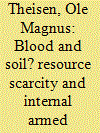

|
|
|
|
|
| Publication |
2008.
|
| Summary/Abstract |
Scarcity of renewable resources is frequently argued to be a main driver of violent conflict. The 2004 and 2007 Nobel Peace Prize awards, as well as the international debate about the implications of climate change, show the salience of the topic as a security issue. Studies testing the link between renewable resource scarcity and armed conflict have reached diverging conclusions. One study, in particular, has found substantial support for eco-scarcity theory, while most others have found a limited association. This article starts with an attempt at replicating earlier findings on the link between population density, soil degradation, deforestation, water scarcity and civil war, but several results are not replicable. The final results lend little support to a purported link between resource scarcity and civil conflict, whereas it replicates earlier findings on the importance of poverty, instability and dependence of fuel exports. A high level of land degradation is the only factor that significantly increases the risk of civil conflict, although this result should be interpreted with caution. The general conclusion of this study is that scarcity of natural resources has limited explanatory power in terms of civil violence, whereas poverty and dysfunctional institutions are robustly related to conflict. Future studies on the link between resource scarcity and violent conflict should focus on local and less intense conflicts, pay more attention to a context of low economic development, look more thoroughly into the role of state actors in the escalatory phase of conflict and assess the importance of the distribution of resources relative to scarcity per se
|
|
|
|
|
|
|
|
|
|
|
|
|
|
|
|
| 3 |
ID:
084996


|
|
|
|
|
| Publication |
2008.
|
| Summary/Abstract |
According to the influential `environmental security' literature, supply-induced scarcity in the form of environmental degradation is a key driver of civil violence around the world. African drylands, especially the Sahel region, are allegedly among the areas most seriously affected by this development. Views of desertification and severe environmental degradation in the Sahel are held by environmental security scholars, despite the comprehensive literature questioning such ideas that has been published since the late 1980s. Instead of being steadily transformed towards more desert-like conditions through increasing population pressure, Sahelian environments are dominated by climatic fluctuations. This article first reviews the literature criticizing the idea of `desertification' as it is applied on African drylands. Then, the article critically discusses the use of the Tuareg rebellion in northern Mali as an example of a supply-induced scarcity related conflict. The case study shows that the droughts of the 1970s and 1980s played a role in the rebellion, but the rebellion was not driven by supply-induced scarcity. Instead, the droughts led to the migration of young men to Algeria and Libya, where they were exposed to revolutionary discourses. There was already a strong feeling among nomads and Tuareg in Mali of being marginalized by state policies of modernization and sedentarization. Embezzlement of drought relief funds by government officials in Bamako added further to the anger felt by the young men who took up arms against the Malian state. The drought of the 1970s and 1980s was probably not a necessary condition for the rebellion to take place. Detailed case studies of armed conflicts, engaging with environmental research, may be necessary to further deepen our understanding of links, or lack of such links, between violence and environmental stress.
|
|
|
|
|
|
|
|
|
|
|
|
|
|
|
|
| 4 |
ID:
084993
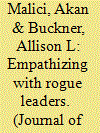

|
|
|
|
|
| Publication |
2008.
|
| Summary/Abstract |
The conventional wisdom regarding Iran and Syria is that these are belligerent states headed by hostile leaders. Rarely is an effort made to imagine how international politics are perceived from the Iranian or the Syrian perspectives, or consider how these perceptions are part of an interactive crisis in which the USA may be implicated as deeply as the regimes in Tehran and Damascus. In this article, we investigate the United States' ongoing crisis with Iran and Syria from the vantage point of their leadership. Our central research questions are: What kind of leaders are Ahmadinejad of Iran and al-Asad of Syria? More specifically, what are their cognitive diagnostic beliefs of the ensuing conflict and their prescriptive beliefs towards it? What is an appropriate strategy for the USA towards Iran and Syria? The answers to these questions speak to the conventional wisdom of Ahmadinejad and al-Asad as hostile and propose strategies for averting a dangerous escalation of the conflict. Our central goal in this article is to develop towards Iran and Syria `realistic empathy' as we consider it `the great corrective for all forms of war-provoking misperception'.
|
|
|
|
|
|
|
|
|
|
|
|
|
|
|
|
| 5 |
ID:
084991
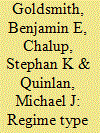

|
|
|
|
|
| Publication |
2008.
|
| Summary/Abstract |
The authors take a new look at the relationship between regime type and deadly militarized conflict among pairs of states (dyads) in the international system. With the goal of describing the general functional form, they evaluate three perspectives: democratic peace, regime similarity and regime rationality. They employ both standard logistic regression (logit) and a recently developed machine learning technique, a support vector machine (SVM). Logit is dependent on assumptions that limit flexibility and make it difficult to discern the appropriate functional form. SVM estimation, on the other hand, is highly flexible and appears capable of discovering a relationship that is contingent on other variables in the model. SVM results indicate that regime similarity and joint democracy are important in most dyadic interactions. However, for the special but important case of the most dangerous dyads, regime rationality plays a role and the democratic peace effect is dominant. The results suggest that models of international conflict excluding distinct indicators for political similarity, joint democracy and joint autocracy may be misspecified. SVMs are an especially useful complement to conventional statistical methods.
|
|
|
|
|
|
|
|
|
|
|
|
|
|
|
|
| 6 |
ID:
084990
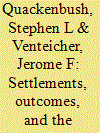

|
|
|
|
|
| Publication |
2008.
|
| Summary/Abstract |
Despite the hope that the resolution of one militarized dispute will bring peace to a dyad, these conflicts often recur. This recurrence of conflict is particularly important because subsequent disputes within a dyad tend to be more severe than previous ones. However, the factors leading to recurrent conflict remain a matter of debate. While some argue that the settlement of a dispute has a significant impact on post-conflict relations, others argue that the outcome of a dispute is the most important determinant of post-conflict stability. Although evidence has been found to support both views, the relative impact of dispute settlements and outcomes has not been satisfactorily determined. Accordingly, this article simultaneously examines the relationship between settlements, outcomes, and conflict recurrence through survival analyses of the periods of peace following 2,973 dyadic militarized interstate disputes between 1816 and 2001. The authors find that although settlement type is an important predictor of recurrent conflict, with imposed settlements being the most stable, outcome type has no significant effects on post-dispute peace duration. The article concludes with a preliminary analysis of the factors that lead to the varying forms of settlement.
|
|
|
|
|
|
|
|
|
|
|
|
|
|
|
|
|
|
|
|
|